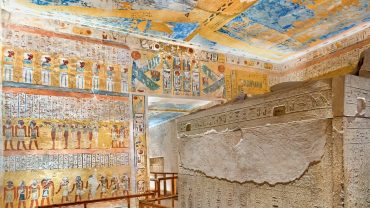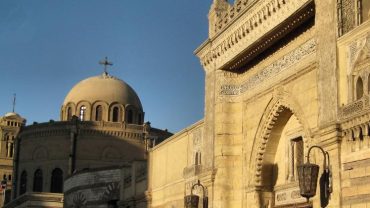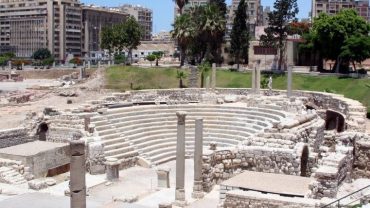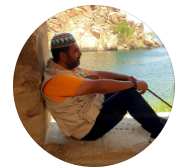Dendera Temple in Qena Egypt | Facts & Reasons for constructing Hathor temple, History of the Pharaonic Temples, plan, architecture, and reliefs.
The temple of Dendera is the best-preserved Pharaonic temple in the whole of Egypt and It is a unique temple in its design. We will explain the history of the temple, the plan, the temple layout, the decorations, and the function of each part.
Besides, the unique Dendera Light Bulb, Dendera Zodiac, Crypts, ceiling, and the Isis temple and Cleopatra reliefs.
Dendera temple Location
The temple of Dendera is located on Luxor West Bank about 65km to the north of Luxor.
What Does it mean Dendera?
The development of the Dendera name started as
In Hieroglyphics: Iun Ta Netr means the city of the God
Greek language: Tan trees (Tentyris)
In Coptic: Tantoura
Arabic name: Ta Netra or Dendera
19th Century: Ta Netra converted into Dendera
It is known that the Nile in Qena has a bend like a moon or half circle and it is the meaning of Qena or the verb Qeni means to hug or protect so Qena means the protected city. Due to this bend, the temple faces north rather than the east-west orientation of other temples.
Dendera Through the history
According to Ancient Egyptian Mythology, Dendera was of the places that witnessed the fight between Horus and Seth. Starting from Pepi I Meryre from the sixth Dynasty, Old Kingdom Dendera became the capital of the 6 Nomes of Upper Egypt.
During the Old Kingdom and the Predynastic Period, the capital was Shabet on the East Bank and the local God was IQ, the crocodile.
The God Crocodile was worshipped in Kom Ombo Temple, Fayoum, and Dendera because of the curve of the Nile in the area. Thus, the curve makes a slow current and a good place for the crocodile to live.
From the beginning of the Old Kingdom, Goddess Hathor changed her cult place from Iunu (Heliopolis) to Dendera. Later on, Hathor became the main Goddess of the area.
To Whom Dendera Temple was Built?
Dendera temple is a very unique Pharaonic temple as it was built for the Goddess Hathor. It is said the oldest temple for Hathor was built during the reign of Khufu (Cheops) and it was designed on leather.
Pepi I Meryre from the sixth Dynasty built the first temple for Hathor but nothing is remains
During the Middle Kingdom, the temple was demolished but Mentuhotep III and Nubkaure Amenemhat II paid attention to the temple.
In The New Kingdom of Ancient Egypt, Thutmose III’s name was found on a stone and was used later
Thutmose III’s name was found in the 3rd Crypt
During the 30th Dynasty, Nectanebo II built the Pharaonic Mammisi.
Ptolemy IX Soter II built the present temple for Hathor in Dendera and it was decorated in the Roman Era by Domitian, Trajan, Claudius, Nero, and Tiberius.
Facts About Dendera Temple Egypt
- Dendera temple on the west bank of the Nile River
- The temple of Dendera took … years to be finished
- Goddess Hathor and Goddess Isis were worshiped side by side in the Dendera temple
- The temple was inaugurated during the reign of the Roman Emperor Augustus
- Isis to the West side while Hathor to the east side
- Hathor temple is an Egyptian temple built in the Greco-Roman Era
- The only Pharaonic temple has a design for Queen Cleopatra VII
- The Nilometer is one of the temple features
- Two Holy of Holies surrounded by 10 shrines rooms
- Like the Kom Ombo temple, the Dendera temple has Sanitarium
- Two Mammisi in Dendera temple
- The ceiling is decorated with astronomical scenes and archaeological zodiac signs
- Eleven crypts are found in the temple of Dendera, one underground, one if a middle level, and the last one at a higher position.
- Yearly, twice a year on February 4 and November 8, the sun is perpendicular to the chapel of Emperor Augustus in the sanctuary
Who Built?
The majority of the Egyptian Pharaonic temples were built on much older temples. Dendera follows the same traditions as it said it was a temple
Ptolemy IX Soter II built the Dendera temple at the end of the second century BC
In general, the Dendera temple is a unique Pharaonic temple in Egypt that was built during the Ptolemaic Dynasty and decorated during the Roman era.
What Materials did they use for building the Dendera temple?
Dendera temple is built out of sandstone, and mudbrick
Temple Layout
- The Port
- Roman kiosk with four pillars
- Gateway of Domitian and Trajan (Hathor Gate)
- Mud brick enclosure wall
- Open Area
- Roman Birth Houses or Mammisi
- Christian Basilica
- Pharaonic Mammisi of Nectanebo I
- Sanatorium
- First Pylon (The façade of the temple)
- Great Hypostyle Hall
- Small Hypostyle Hall (the hall of appearances)
- 6 Small chambers on both sides of the small hall
- Offering Hall
- Hall of the Ennead
- Barque Shrine
- 11 Chapels for different deities
- Mysterious Fourteen crypts
- Goddess Nut chamber
- The Roof
- Isis temple
- Sacred Lake
- Nilometer
- Chapel of Montuhotep
Why Dendera Temple was built?
The temple of Dendera was built for the Goddess Hathor, one of the main goddesses in ancient Egyptian religion.
Hathor is known since the Predynastic Era and she was portrayed on the Narmer Palette
Hathor was portrayed as a cow, cow-headed woman, a woman with the ears of a cow, and a woman with cow horns and a sun disc in between.
The Goddess Hathor was the goddess of love, joy, happiness, motherhood, and sky goddess.
Together with Isis, and Mut, Hathor was symbolizing the maternal and celestial.
The second reason, the temple had a sanitarium and seems like the Kom Ombo temple was used as a hospital.
Dendera temple architecture and reliefs
The Port of Dendera temple Egypt
Like all the Pharaonic temples, the Dendera temple was connected to the Nile River through a canal that ends with a harbor. So, they transported stones and goods from everywhere to the harbor and from the harbor inside the temple.
Roman Kiosk
There is a Roman kiosk with four pillars in front of the pro-pylon and seems it was an accessories shop to sell the visitors things before they go in.
Sphinxes with no heads
There are two Sphinxes in front of the gateway with no heads and we are not sure if it was the Avenue of Sphinxes in front of the temple or not.
The Gateway of Domitian and Trajan
We enter Hathor temple now through a huge stone gate built by Domitian and emperor Trajan finished the reliefs. The gate carries beautiful reliefs on both sides as follows
- Emperor Domitian dresses like an Egyptian Pharoah and offers Sistrum to Hathor, Horus of Edfu, and their son Ihy or Horus Sema Tawy
- Domitian in a libation scene in front of Hathor
- Behind the gate door, we see different ancient signs, Nb, Was, and Ankh symbols of gold, stability, and happiness
- Gods with knives to protect the temple and the entrance
- Scarab pushes a ball(sun) in front of it
- Winged sun with two cobras for protection
- Isis feed Horus breast-feed in front of Domitian
- The emperor with the Atef crown offers the temple to Isis
- Roman emperor Domitian offers milk, and a headdress to Hathor and Sekhmet
The back of the Gateway
At the top, Domitian but the relief is not existing anymore in front of
Isis, Osiris, Horus the elder, and Horus Sema Tawy with snake head
On the other side left
Domitian in front of Hathor, Horus Edfu, Ihy, and Horus, son of Isis
different scenes for Domitian offers sacrifices and burns incense, and oils to Hathor and Isis.
In the middle of the gateway, we can see the face of Hathor on the NB sign means gold
Mud brick enclosure wall
The temple of Dendera is surrounded by a mud-brick enclosure wall of 280*290m with a thickness at the bottom of 10-12m with a height of 10m. The enclosure is almost equal to 137 000 m3 or in other words almost 65 000 000 blocks enough to build a small town.
Mammisi of Dendera temple Egypt
The Mammisi is a new feature that was added to the Pharaonic temples built in the Greco-Roman Period. Dendera temple, Edfu temple, Temple of Philae together with Kom Ombo temple all have Mammisi or Birth Houses.
The Mammisi can be found in many temples, sometimes outside the temple like Karnak temple and sometimes Part of the temple like Edfu temple.
The word Mammisi or Mamisi is derived from two ancient Egyptian words Ma Miss means the place of Birth. The Dendera temple has two Mammisi that was built by the Egyptian Pharaoh Nectanebo and the Roman Emperor Augusts.
The façade of the temple
The façade consists of 6 columns and between them, the stone screen walls carry scenes of the Roman Emperor Tiberius and other Roman rulers who present votive offerings to the Goddess of the Temple.
Its scenes depict Trajan, Augustus’ later successor, making offerings to Hathor, and are among the finest to be found in Egypt.
The upper, front edge of the cornice is decorated with the winged sun disc, the symbol of protection. The columns are decorated with four-sided heads of the goddess Hathor.
Great Hypostyle Hall of Dendera
First of all, this Hypostyle Hall is a Roman Hall as all the names here for Roman emperors such as Tiberius, Caligula, Claudius, and Nero. We did not find any Ptolemaic names here. This was finished in 34 AD in Tiberius’ 20th year.
The Great hypostyle hall of the Hathor temple in Dendera is supported by 24 Hathoric columns. The front row, connected by six screen walls represents the façade. In the middle of which, the face of the Goddess Hathor, suppose to cover with gold in the past.
The entrance to Dendera temple is in the middle of the screen walls and at its top, there are 413 names for the Goddess Hathor. To the right and left are the two triads of the temple for Isis, Hathor, Horus, and Horus sema tawy.
Dendera Hypostyle Hall reliefs
In general, the scenes on the walls of the Hypostyle Hall are matching right and left. Firstly, to the right-hand side of the entrance
- The Roman emperor with the red crown leaves his palace and behind him is his KA and in front of him, the priest burns the incense.
- In front of the emperor 4 stands with the signs of Wapwawet the opener of the roads, Djehuty, Horus, Hathor’s husband, and Dendera cemetery sign as the king says he is the Heir of the kings.
- Next scene, the king is purified between Horus and Thoth
- Then, he is crowned between Nekhbet and Wadjet of Upper and Lower Egypt
The West wall of the Hypostyle Hall
- The king with the deities like God Montu, and God Atum in front of Goddess Hathor.
- Roman emperor with Goddess Seshat taking the measurements of the temple
- Tiberius offers the temple to Hathor, Horus, and Hor sema tawy
- Offering the Maat sign to Hathor
The South Façade of the Hypostyle Hall
It was the end of the temple before the Roman Era and it was built in 54 BC by Ptolemy XII and Cleopatra VII. The scenes of this part date back to Caesar Augustus. Meanwhile, the bottom registers of this wall were decorated by Tiberius and Caligula.
The ceiling of the Pronaos of Dendera temple Egypt
This is the best preserved and decorated ceiling in all the Pharaonic temples. The ceiling is divided into 7 sections and the middle of it is decorated with the vulture goddess Nekhbet for protection.
In the other 6 sections, every two sections complete each other. The first section completes the seventh and they have all the star’s signs or the Zodiac signs
The 2nd and the 5th sections represent the 12 hours of the day and the 12 hours of the night.
The 3rd and the 6th section contain the phases of the moon.
The first and the seventh register contain all the zodiac signs we know today but we should notice
The first zodiac sign for them was the Lion because the year starts in the past with the Nile flood between 20-28 July. So, the first zodiac sign was Lion, then Virgo, Libra, Scorpion, Sagittarius, Capricorn, Aquarius, Pisces, Aries, Tauris, Gemini, and Cancer.
Each star sign had its own energy and power, some once a year and others more than twice.
The Nilometer of Hathor temple
Dendera Nilometer is located in the northwest part of the temple complex and it is a very deep hole connected to the Nile River. The function of the Nilometer is to measure the Nile Flood during the flood season.
That was the way how the ancient Egyptian Government calculated the taxes in the past. When the flood is very high and destroyed everything, were no taxes. Meanwhile, if the flood was so low, means they won’t be able to grow crops, no taxes. If the flood in the right level, farmers should pay taxes as crops or working days for the government.
Dendera Feasts
Dendera festivals are two of many ceremonies and festivals the ancients celebrated in the temples. On the southern walls of the temple of Ramses second are inscribed the names of more than 60 festival days between the lunar festivals and the Egyptian civil year.
In general, there were two types of ceremonies in the past
- Daily ceremonies took place every day inside the temples
- yearly feasts were celebrated once a year
The feasts normally include the purification of the god’s statue, changing the clothes of the god and clothing him with linen, perfuming the statue, burning incense trees in front of the statue, and adorning the statue with regalia.
The purpose of the feasts was focused on fertility, birth, and continued renewal of life.
One of the most beautiful feasts in the past was the feast of the beautiful reunion between Hathor and Horus of Edfu which took place during Shomu, the Harvest season.
The Feast of the beautiful Reunion
When we talk about the Dendera temple we have to remember very important two feasts that took place in the temple in ancient times.
- The first one is called the beautiful feast of the reunion
- The second one is called New Year’s Day.
We will start with the first feast of the good union between the husband (god Horus) of Edfu and the wife (Goddess Hathor) of Dendera.
Our information about the feast came from some rooms in the Dendera and Edfu temples. So now we will abbreviate how they celebrated the feast. when it was taking place? who shares in that feast? And why they celebrated the feast?
The festival took place in the third month of Shemu, which would be late May or early June on our calendar. Hathor of Dendera will go upriver to Edfu to visit her husband in Edfu temple, spending together sometimes then back to her temple but how it started from the first beginning
Is known for us In ancient Egypt, every day in every temple, The high priest performed a ritual focused on making offerings of food, drink, clothing and ointment, to a divine being (deity of the temple).
Those designated persons were The King-High Priest, Second Prophet of the God (Censor), Third Prophet of the God, 2 Priests and 2 Priestesses of Upper and Lower Egypt, 2 Gods, 4 (or more) W3b Priests, Assembled Priests
These daily rituals are ritual cycles that were performed twice or three times daily. Ancient Egyptian temples provided for the basic physical needs of deities and ancestors.
Dendera temple Egypt Festivals Description
The day feast started like any normal day with the purification of the priests in the sacred lake then they prepare or chant some formula before they reach the sanctuary like the formula for lighting the fire, taking the censer, placing the offering-cup on the censer, placing the incense on the flame, proceeding to the sacred place which is room has no windows, no doors except one door in one side.
The door of the shrine was made out of wood with two leaves and inside that room was the pedestal made out of stone (alabaster or granite or limestone) on that pedestal was the Naos, like a box made out of wood covered with gold in most of the cases and it has wooden door also out of two leaves. Inside that Naos, was the statue of the deity of the temple.
Then the sealed shrine is then opened, by breaking the seal and untying the cord around the door knobs, the person conducting the ritual (King or high priest) bows in front of the image of the deity with two main gestures: kissing the ground and raising his arms while singing hymns then offerings of incense and scented oil are made.
Later on, the image is robed, with an offering of four lengths of cloth, each with a different name, the image is offered scented oil and green (copper) and black (lead) eye paint, and the person conducting the ritual with the help of other priests carry the figure of Hathor on her sacred boat going around the temple to show her everything in the temple before they will take the statue back to the shrine then the high priest withdraws from the shrine, sweeping away his footprints, and offering Natrun, incense, and water.
Sacred Marriage of Hathor and Horus | Reunion feast of Hathor and Horus
But on the Dendera festivals day, they start the normal day and they make all the previous steps then the boat bearing the sacred statue of Hathor would be taken from its sanctuary at Dendera, placed on the Nile’s vessel, and borne upstream in a splendid procession.
Meanwhile, that of Horus would set off downstream, also amidst great fans. Where the boats met, they would be encircled by a rope cast by other vessels in a gesture of unity. Then, together, the river crafts would make their way to the appropriate temple to celebrate the reunion of husband and wife amidst joy, song, and prayer.
The feast may have taken as long as two weeks this was in essence a “conjugal visit” between Hathor and Horus of Behdet and a renewal of their sacred marriage. Following her visit to Horus at Edfu, Hathor’s statue and retinue would return to Dendera for another celebration to mark the birth of Horus and Hathor’s divine child.
New Year’s Day
The second great Dendera festival took place on the ancient New Year’s Day, when the image of Hathor, which was believed gradually to have lost efficacy in the darkened sanctuary in the course of the year, would be taken to the top of the temple to be reimbued with power from the rising sun.
This festival is depicted in the antechamber of the temple, where there are passages on both sides leading to staircases that ascend to the temple roof. The chapel where they keep the goddess facing east to receive the first rays of the rising sun on her face is very similar to the kiosk of Trajan in Philae temple and will be facing the one who will take the staircase up to the second floor.
Dendera Light Bulb
There is a design located in a crypt in the temple dedicated to Ht-Hr (Hathor), in Dendera temple Egypt called the light bulb. We have no evidence that it was a light bulb or even Egyptians know the light system at that time.
The view of Egyptologists is that the relief is a mythological depiction of a Djed pillar and a lotus flower, spawning a snake within, representing aspects of Egyptian mythology. The Djed pillar is a symbol of stability which is also interpreted as the backbone of the god Osiris.
In the carvings, the four horizontal lines forming the capital of the Djed are supplemented by human arms stretching out, as if the Djed were a backbone. The arms hold up the snake within the lotus flower. The snakes coming from the lotus symbolize fertility, linked to the annual Nile flood.
Mysterious Fourteen crypts
One of the highlights of the Dendera temple is the 14 crypts between those underground, on the ground level, and high into the walls of the temples. The crypts are not only here in Dendera but we can trace them back to the 18th Dynasty.
Starting from the Greco-Roman era most of the Pharaonic temples included crypts. Their main use of these crypts was for keeping cult equipment, archives, and magical emblems for the temple’s protection, though the most important object kept in the crypts was a statue of the Ba of Hathor
Opening Hours of Hathor temple
Dendera temple is open daily from 07.00 am to 17.00 pm.
Dendera temple Ticket price
You can purchase an Entrance ticket for Dendera Temple from the Ticket window which is facing the entrance of the visitor center.
Adult: EGP 120 (12.6 $)
Students with valid cards: EGP 60(6.3 $)
Children aged 6-12 years: EGP 60 (6.3 $)
Children under 6 years: FREE
Tips for visiting Dendera temple Egypt
- Dendera temple (Hathor temple) is a very unique temple in Egypt and it is very well-preserved. However, the temple has unique reliefs and an astronomical ceiling, a calendar, and many confusing scenes like the Dendera lamb. So, visit the temple with an archeologist guide.
- You will learn a lot about Egyptian History, Egyptian religion, and Greco-Roman History in Egypt.
- Read before you go and make up your questions list to ask your guide and know more about Pharaonic temples and the Pharaonic Religion.
- Take extra water with you and some snacks, especially in the summer months, and drink at least 5 small bottles of mineral water to not hydrate.
- Small change for the WC
- Do not forget to take your hat, sunglasses, and suncream with you
- Cotton dress during summer
Conclusion
Dendera temple operated as a healing temple and ISIS was mentioned as a great healer. The temple of Dendera is the feminine Heart Chakra energy and a place where you take a look at the simulation between the microcosmic and the macrocosmic in ancient times
The Dendera temple houses the energy of sensuous Hathor, goddess of dance, music, love, frivolity, and ecstasy
Hathor temple at Dendera has 1200 scenes compared to Kom Ombo temple with 400 scenes and Edfu temple with 1912 scenes.
In the Dendera temple, you will be experiencing the deep meaning of partnership, marriage will be a simple of such relationship. Are you a good partner? Are you attracting a good partner? What does cooperation mean in your life? What are you ready to give and ready to receive? You will be experiencing magic, the flow of positive feelings, and the release of negative feelings.





Comment (0)